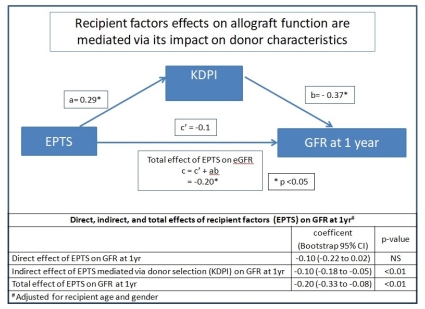Quantification of the Indirect Effect of Recipient Characteristics on Kidney Graft Function
1Medicine, Lewis Katz School of Medicine, Temple University, Philadelphia, PA
2Surgery, Lewis Katz School of Medicine, Temple University, Philadelphia, PA.
Meeting: 2018 American Transplant Congress
Abstract number: B82
Keywords: Allocation, Glomerular filtration rate (GFR), Kidney transplantation, Renal function
Session Information
Session Name: Poster Session B: Kidney Deceased Donor Allocation
Session Type: Poster Session
Date: Sunday, June 3, 2018
Session Time: 6:00pm-7:00pm
 Presentation Time: 6:00pm-7:00pm
Presentation Time: 6:00pm-7:00pm
Location: Hall 4EF
Recipient characteristics play an important role for donor selection in deceased donor kidney transplant recipients (DDKT). The current kidney allocation system (KAS) for deceased donors has been designed to enhance recipient and donor matching, based on EPTS and KDPI scores. Additionally, transplant centers accept each kidney offer for selected patient on their waiting list according to patient characteristics.
The purpose of this study was to assess the indirect effect of recipient characteristics on kidney graft function mediated through its influence on donor selection.
We studied 138 consecutive DDKT from 1/2011 to 2/2016 at a single institution. SPSS 24 with PROCESS software was used to conduct the mediation analysis. Mean recipient age was 57±12y and EPTS was 60±29%. The majority were males (60%) and AA (65%). Mean donor age was 38±14y and KDPI was 45±24%. Mean GFR at 1yr post-kidney transplant (KT) was 56±23 ml/min (CKD-EPI).
After adjusting for recipient gender and race, EPTS significantly influenced KDPI: 10% increase in EPTS was associated with 2.9% increase in KDPI (p<0.01). Also, 10% increase in KDPI was associated with 3.7ml/min decrease in GFR at 1yr post-KT (p<0.01). The total effect of EPTS on GFR was significant: 10% increase in EPTS was associated with a reduction in GFR of 2ml/min (p<0.01). The mediation model analysis showed that the indirect effect of EPTS resulting from its influence on KDPI was significantly associated with lower GFR at 1yr post-KT (p<0.01), while the direct effect of EPTS on GFR was insignificant. 
Conclusions: KT recipients with higher EPTS have lower GFR at 1yr post-KT mainly as result of EPTS and KDPI matching rather than a direct effect of recipient on kidney graft function. We propose that statistical analyses for kidney graft outcomes should incorporate the effect of this interaction. Additional studies are warranted to assess the impact of recipient-donor interaction on long-term kidney graft survival especially in the context of the current KAS.
CITATION INFORMATION: Rao S., Gillespie A., Lee J., Lau K., Karhadkar S., Di Carlo A., Constantinescu S. Quantification of the Indirect Effect of Recipient Characteristics on Kidney Graft Function Am J Transplant. 2017;17 (suppl 3).
To cite this abstract in AMA style:
Rao S, Gillespie A, Lee J, Lau K, Karhadkar S, Carlo ADi, Constantinescu S. Quantification of the Indirect Effect of Recipient Characteristics on Kidney Graft Function [abstract]. https://atcmeetingabstracts.com/abstract/quantification-of-the-indirect-effect-of-recipient-characteristics-on-kidney-graft-function/. Accessed December 17, 2025.« Back to 2018 American Transplant Congress
